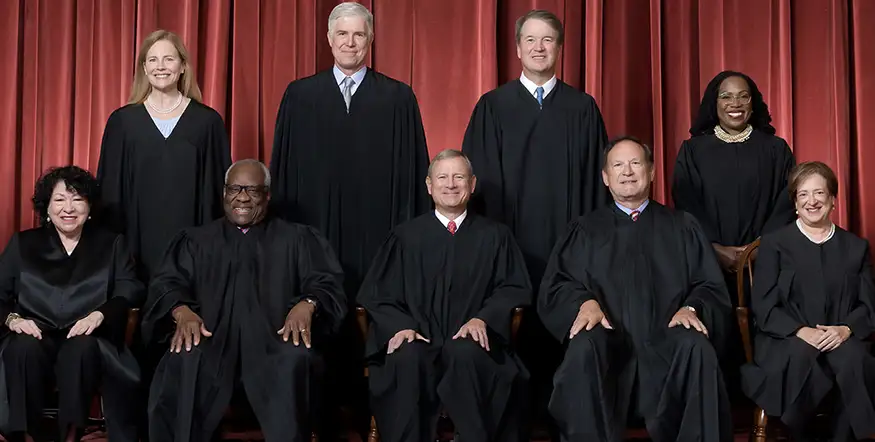
In a piece recently published by The Atlantic, Steven Mazie speculates that there might be personal animosity on the Supreme Court and places the blame on the conservative justices. This claim seems alarming, as Mazie suggests deteriorating relationships that could threaten the functioning of the Court. However, Mazie’s argument is based on such limited evidence and ignores enough evidence to the contrary that the article has more speculation than insight.
Mazie claims that Justice Gorsuch raising an eyebrow at one of Justice Sotomayor’s statements and Justice Roberts placing his hand on his chin during a lawyer’s argument are proof of a hostile new environment at the Court. Although these observations may be accurate, it is difficult to believe that these momentary reactions demonstrate anything meaningful about the relationships on the Court. Mazie also claims that “The seating arrangement—by tradition, the newest justices sit on the wings—exacerbates the tension.” He does not say why this exacerbates the tension but seems to expect his readers to assume that sitting next to a conservative justice is such a traumatic experience that interpersonal tension is the inevitable result.
Recent statements from the justices also weaken Mazie’s argument. In a recent speech, Justice Alito talked warmly of his relationship with Justice Sotomayor and their ongoing bets on baseball games. Sotomayor has also expressed admiration for the character of Justice Thomas, despite their ideological disagreements. Mazie also paints an incomplete picture by focusing on the highest profile cases, which are usually more contentious. For nine of the past ten terms, more cases were decided by a 9-0 majority than any other margin. Even the 2021 term, which saw an increase in divided decisions, still had significantly more 9-0 or 8-1 decisions than 6-3 or 5-4. Furthermore, several of the divided decisions were made of a majority that defied ideological classification, such as Ysleta del Sur Pueblo v. Texas, where Justices Barrett, Kagan, Sotomayor, and Breyer joined Justice Gorsuch’s majority opinion.
On applications for emergency relief, the Court is also surprisingly united. During the 2021 term, the two justices most likely to disagree, Clarence Thomas and Sonia Sotomayor, agreed on over 66% of emergency relief applications. While there are certainly ideological differences on the Court, the frequency with which the justices agree suggests that their working relationships are much better than Mazie claims.
Even just a few years ago, this would not have been a story. No reasonable person would expect all nine Justices to agree on every case but would expect them to ask pointed questions or otherwise express disagreement. Many on today’s Left, however, increasingly interpret disagreement as a threat to their safety and respond accordingly. Examples of this mindset abound on college campuses where liberal students often claim speakers of opposing viewpoints constitute an attack from which “protection” is required. This explains Mazie’s oddly specific claim about the Court’s seating arrangement; if the views of Justices Thomas and Kavanaugh are “dangerous,” then sitting next to them would be problematic for their colleagues.
As the Left continues to conflate disagreement with physical danger, they have been more willing to threaten violence themselves. Several years ago, Democrat Senate Majority Leader Chuck Schumer warned conservative justices that they “will pay the price” and “won’t know what hit [them] if [they] go forward with these awful decisions [in abortion cases].” Mazie fails to address what role these threats could have in increasing tension on the Court.
Furthermore, the leak of the Dobbs decision also went unmentioned. This leak was the most significant breach of the Court’s confidentiality in memory, and it would be reasonable to wonder if the ongoing failure to find the source of the leak could contribute to a breakdown in trust. As a result of the leak, a man attempted to assassinate Justice Kavanaugh at his home and other justices faced calls for violence against them. If Mazie were interested in exploring the possibility of rising tension on the Court, this would be the logical place to start. Instead, his focus on the nonverbal cues of particular justices and the Court’s seating arrangement shows the article to be nothing but a partisan hit-piece.
Cases that come before the Court are difficult and often require decisions on subjects that the Constitution does not directly address. This will inevitably lead to disagreements amongst the justices. This disagreement, however, can strengthen our judiciary by ensuring that weak arguments are exposed, and decisions are developed with clarity and precision. Mazie assumes that these disagreements constitute personal tension, but his argument lacks the evidence needed to convincingly make this case.
SUPPORT LANDMARK LEGAL FOUNDATION
We are truly facing existential threats to our individual rights and liberties, the Constitution, and our national character. If unchallenged, this assault on our very way of life will ruin our great nation. With your financial and moral support, Landmark is not going to let that happen without a fight. Will you join us?





